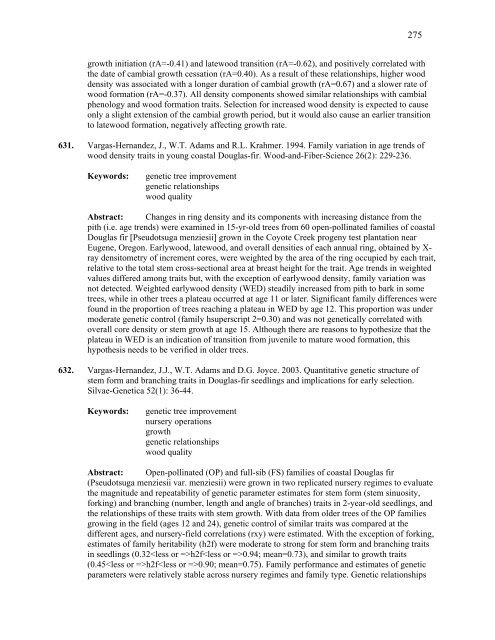IntensIve sIlvIculture - Forest Science Labs - Research Network ...
IntensIve sIlvIculture - Forest Science Labs - Research Network ...
IntensIve sIlvIculture - Forest Science Labs - Research Network ...
Create successful ePaper yourself
Turn your PDF publications into a flip-book with our unique Google optimized e-Paper software.
275<br />
growth initiation (rA=-0.41) and latewood transition (rA=-0.62), and positively correlated with<br />
the date of cambial growth cessation (rA=0.40). As a result of these relationships, higher wood<br />
density was associated with a longer duration of cambial growth (rA=0.67) and a slower rate of<br />
wood formation (rA=-0.37). All density components showed similar relationships with cambial<br />
phenology and wood formation traits. Selection for increased wood density is expected to cause<br />
only a slight extension of the cambial growth period, but it would also cause an earlier transition<br />
to latewood formation, negatively affecting growth rate.<br />
631. Vargas-Hernandez, J., W.T. Adams and R.L. Krahmer. 1994. Family variation in age trends of<br />
wood density traits in young coastal Douglas-fir. Wood-and-Fiber-<strong>Science</strong> 26(2): 229-236.<br />
Keywords: genetic tree improvement<br />
genetic relationships<br />
wood quality<br />
Abstract: Changes in ring density and its components with increasing distance from the<br />
pith (i.e. age trends) were examined in 15-yr-old trees from 60 open-pollinated families of coastal<br />
Douglas fir [Pseudotsuga menziesii] grown in the Coyote Creek progeny test plantation near<br />
Eugene, Oregon. Earlywood, latewood, and overall densities of each annual ring, obtained by Xray<br />
densitometry of increment cores, were weighted by the area of the ring occupied by each trait,<br />
relative to the total stem cross-sectional area at breast height for the trait. Age trends in weighted<br />
values differed among traits but, with the exception of earlywood density, family variation was<br />
not detected. Weighted earlywood density (WED) steadily increased from pith to bark in some<br />
trees, while in other trees a plateau occurred at age 11 or later. Significant family differences were<br />
found in the proportion of trees reaching a plateau in WED by age 12. This proportion was under<br />
moderate genetic control (family hsuperscript 2=0.30) and was not genetically correlated with<br />
overall core density or stem growth at age 15. Although there are reasons to hypothesize that the<br />
plateau in WED is an indication of transition from juvenile to mature wood formation, this<br />
hypothesis needs to be verified in older trees.<br />
632. Vargas-Hernandez, J.J., W.T. Adams and D.G. Joyce. 2003. Quantitative genetic structure of<br />
stem form and branching traits in Douglas-fir seedlings and implications for early selection.<br />
Silvae-Genetica 52(1): 36-44.<br />
Keywords: genetic tree improvement<br />
nursery operations<br />
growth<br />
genetic relationships<br />
wood quality<br />
Abstract: Open-pollinated (OP) and full-sib (FS) families of coastal Douglas fir<br />
(Pseudotsuga menziesii var. menziesii) were grown in two replicated nursery regimes to evaluate<br />
the magnitude and repeatability of genetic parameter estimates for stem form (stem sinuosity,<br />
forking) and branching (number, length and angle of branches) traits in 2-year-old seedlings, and<br />
the relationships of these traits with stem growth. With data from older trees of the OP families<br />
growing in the field (ages 12 and 24), genetic control of similar traits was compared at the<br />
different ages, and nursery-field correlations (rxy) were estimated. With the exception of forking,<br />
estimates of family heritability (h2f) were moderate to strong for stem form and branching traits<br />
in seedlings (0.32h2f0.94; mean=0.73), and similar to growth traits<br />
(0.45h2f0.90; mean=0.75). Family performance and estimates of genetic<br />
parameters were relatively stable across nursery regimes and family type. Genetic relationships
















